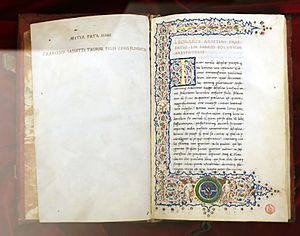Poetics facts for kids

Poetics is a way of understanding how literature and poetry are built. It looks at their structure, form, and the way they use language. Think of it as studying the "how-to" of writing and storytelling.
Contents
The History of Poetics
The word poetics comes from an Ancient Greek word, poietikos. This word means "having to do with poetry" or "creative."
In the Western world, the idea of poetics changed over time. Three main ways of thinking shaped it:
- The formalist approach, which focuses on the form and structure of a work.
- The objectivist approach, which looks at the text itself.
- The Aristotelian approach, based on the ideas of Aristotle.
Aristotle's Influence
Aristotle was an ancient Greek philosopher. His book, Poetics, is one of the first important writings about literary theory. For a long time, this book was lost to the Western world.
During the Middle Ages and early Renaissance, people in the West only knew about Aristotle's Poetics through an Arabic translation. This translation was made by Averroes and then translated into Latin. This led to some misunderstandings of Aristotle's original ideas.
Poetics in the Renaissance
Modern poetics really started to grow in Renaissance Italy. People needed to understand old texts, especially in the light of Christianity. They also wanted to study the stories of famous writers like Dante, Petrarch, and Boccaccio. This helped new ideas about literary theory to develop.
Thanks to Giovanni Boccaccio's book Genealogia Deorum Gentilium (written around 1360), educated people learned a lot about metaphors and other figurative language.
In 1498, Giorgio Valla published the first Latin translation of Aristotle's text. Later, many more books on poetics appeared. This started in Italy and spread to Spain, England, and France. Important works from this time include De arte poetica (1527) by Marco Girolamo Vida and La Poetica (1529) by Gian Giorgio Trissino.
By the 1500s, versions of Aristotle's Poetics started appearing in everyday languages. Lodovico Castelvetro's Italian editions in 1570 and 1576 were very important. Later, writers like Luis de Góngora and Baltasar Gracián added new ideas to poetry. Emanuele Tesauro wrote about clever figures of speech in his book Il Cannocchiale Aristotelico (1654).
Later Developments
During the Romantic era, poetics focused more on how the writer felt and expressed themselves. In the 20th century, poetics returned to some of Aristotle's ideas. It also developed new ways of thinking about how we study literature.
Eastern poetics, like that in Asia, often focused on lyric poetry. This is different from the Western world's focus on mimetic poetry, which tries to imitate reality.
Poetics in Literary Analysis
Poetics is different from hermeneutics. Hermeneutics is about finding the meaning of a text. Poetics, on the other hand, focuses on how a text's different parts work together. It looks at how these parts create certain feelings or effects for the reader.
Most literary criticism uses both poetics and hermeneutics. However, one might be more important depending on the text and what the reader wants to understand.
See also
 In Spanish: Poética para niños
In Spanish: Poética para niños
- List of basic poetry topics
- Cognitive poetics
- Descriptive poetics
- Historical poetics
- Figure of speech
- Poetry analysis
- Stylistic device
- Rhetorical device
- Meter (poetry)
- Allegory
- Allusion
- Imagery
- Musical form
- Symbolist poetry
- Sound poetry
- Refrain
- Literary theory
- History of poetry
- Poetics and Linguistics Association
- Theopoetics


